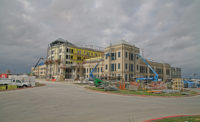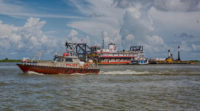...the river by rafts and ferries run by local residents. There are only a few larger vessels that can transport larger vehicles and trucks carrying cargo.
The Peruvian government first tackled the problem in the late 1970s, taking delivery of $10 million worth of structural steel from the Austrian firm Waagner Biro AG while the construction plans for the span were being finalized.
Yet the early 1980s were a period of significant turmoil for Peru. A violent insurgency gripped the southern highlands, and the economic stability of the nation teetered dangerously. In 1984, the project was mothballed indefinitely.
The bridge components eventually were stored near Puerto Maldonado, but the warehouse was partially damaged in a fire. As a result, many of the bridge sections and cables were left exposed to the jungle climate for years.
With the advent of the highway job in 2005, the Peruvian government relaunched Billinghurst Bridge construction. In 2006, the project was awarded to the Madre de Dios Consortium, which consisted of Pedro Láinez-Lozada Ingenieros S.A., Incot S.A.C. and the Colombian firm Conciviles S.A.
The group went to work on the concrete support pillars in the river and the bridge’s substructures on either side of the waterway. The 30-month project was knocked off track when the consortium balked at the government’s price of $22 million for the job after seeing the condition of the steel body and cabling.
Eventually, the group backed out of the job entirely, and the Peruvivan government was forced to put the work out to bid again. Two attempts attracting bidders went unanswered, and Ositran approached Conirsa to help.





















Post a comment to this article
Report Abusive Comment